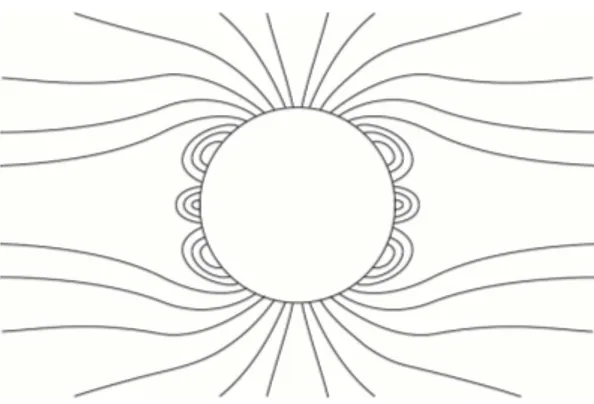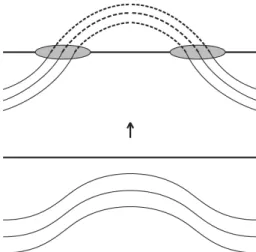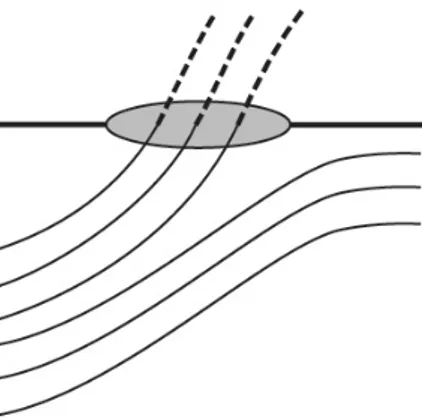April, 2013 PROGRESS IN PHYSICS Volume 2
LETTERS TO PROGRESS IN PHYSICS
Commentary on the Liquid Metallic Hydrogen Model of the Sun:
Insight Relative to Coronal Holes, Sunspots, and Solar Activity
Pierre-Marie Robitaille
Department of Radiology, The Ohio State University, 395 W. 12th Ave, Columbus, Ohio 43210, USA. robitaille.1@osu.edu
While mankind will always remain unable to sample the interior of the Sun, the presence of sunspots and coronal holes can provide clues as to its subsurface structure. Insight relative to the solar body can also be gained by recognizing that the Sun must exist in the condensed state and support a discrete lattice structure, as required for the production of its continuous spectrum. In this regard, the layered liquid metallic hydrogen lattice advanced as a condensed model of the Sun (Robitaille P.M. Liquid Metallic Hydrogen: A Building Block for the Liquid Sun. Progr. Phys., 2011, v. 3, 60–74; Robitaille P.M. Liquid Metallic Hydrogen II: A Critical Assessment of Current and Primordial Helium Levels in Sun. Progr. Phys., 2013, v. 2, 35–47; Robitaille J.C. and Robitaille P.M. Liquid Metallic Hydrogen III. Intercalation and Lattice Exclusion Versus Gravitational Settling and Their Consequences Relative to Internal Structure, Surface Activity, and Solar Winds in the Sun. Progr. Phys., 2013, v. 2, in press) provides the ability to add structure to the solar interior. This constitutes a significant advantage over the gaseous solar models. In fact, a layered liquid metallic hydrogen lattice and the associated intercalation of non-hydrogen elements can help to account for the position of sunspots and coronal holes. At the same time, this model provides a greater understanding of the mechanisms which drive solar winds and activity.
As the laws of a liquid are different from those of a gas, a liquid star will behave differently from a gaseous star, and before we can predict the be-haviour of a star we must know the state of the mat-ter composing it.
James Hopwood Jeans, 1928 [1]
Coronal holes are strange entities, in part due to their sparse nature [2, 3]. At first glance, they seem to offer little of value with respect to our understanding of the Sun. What can be gained from “looking into a hole”? Within the context of the liquid hydrogen model of the Sun (see [4–10] and references therein), there is a great deal to be learned.
In the broadest terms, coronal holes can be described as follows: “Coronal holes are regions of low-density plasma on the Sun that have magnetic fields that open freely into interplanetary space. During times of low activity, coronal holes cover the north and south polar caps of the Sun. Dur-ing more active periods, coronal holes can exist at all solar latitudes, but they may only persist for several solar rotations before evolving into a different magnetic configuration. Ion-ized atoms and electrons flow along the open magnetic fields in coronal holes to form the high speed component of the so-lar wind”[2]. When the Sun is quiet, coronal holes appear to be“anchored”onto the polar regions of solar surface (see Fig. 1): “coronal holes, in fact, appear to display rigid rota-tion as if they are attached to the solar body”[11, p. 24].
The anchoring of coronal holes to the solar surface can be viewed as the twenty-second line of evidence that the Sun
Fig. 1: Schematic representation of coronal holes over the polar caps of a quiet Sun. This figure is an adaptation based on Fig. 2 in [2].
is comprised of condensed matter. The other lines of evi-dence have already been published (see [4–10] and references therein). Rigid rotation and anchoring cannot be easily ex-plained using the gaseous solar models. As a result, the an-choring of coronal holes is best understood in the context of a condensed solar model.
In order to comprehend why the Sun possesses coronal holes, it is best to turn to the lattice configuration of the solar material. Robitaille and Robitaille [7] have recently advanced the hypothesis that the Sun is comprised of liquid metallic hydrogen, wherein protons are arranged in layered hexagonal planes and all other atoms exist in intercalate layers located between the hydrogen planes. Such a structure has been based
Volume 2 PROGRESS IN PHYSICS April, 2013
on the need to properly explain the thermal emission of the Sun [5], while at the same time, taking into account the struc-tural tendencies of layered materials such as graphite [7].
Within the intercalation compounds of graphite, elemen-tal diffusion orthogonal to the hexagonal carbon planes is hin-dered, while rapid diffusion can occur in the intercalate re-gions between the planes (see Fig. 2 in [7]). The same ten-dencies have been inferred to exist within the liquid metallic hydrogen lattice of the Sun: elemental diffusion is restricted in the direction orthogonal to the hexagonal proton planes and is greatly facilitated within each intercalate layer [7].
Hence, in order to explain the existence of coronal holes, the hexagonal liquid metallic hydrogen lattice of the Sun must be placed in a direction which is orthogonal to the solar sur-face at the poles. This would explain why the expulsion of ions and electrons from the Sun is facilitated. The subsurface orthogonal placement of the liquid metallic hydrogen hexag-onal planes thus accounts for the origin of fast solar winds in these regions. During the quiet periods of the solar cycle, the relative orientation of the hydrogen lattice at the poles forms conduits to drive non-hydrogen elements out of the so-lar body. As a result, the travel time from the soso-lar core to the surface may well be extremely brief. Given a solar ra-dius of∼696,342 km (see [10] and references therein) and a
fast solar wind of 800 km/s [2], an atom could conceivably leave the solid core of the Sun and escape at the level of the photosphere on the poles in only fifteen minutes.
Nonetheless, during the quiet period of the solar cycle, the equatorial regions of the Sun are unable to sustain fast solar winds. This is likely to occur because the hexagonal layers of liquid metallic hydrogen are parallel to the solar surface in this region. Such an arrangement would restrict the free diffusion of elements from the solar body near the equator, resulting in the absence of fast solar winds. Only the slow component of the solar wind would be observed, pre-cisely because of restricted diffusion of the elements across the hexagonal hydrogen planes [7]. As a result, the concen-trations of non-hydrogen elements in the equatorial region of the interior would increase. Eventually, the Sun would be-come active in order to finally expel these elements from the hydrogen lattice, as was previously stated [7].
Sunspots would be created as hexagonal hydrogen layers are propelled through the solar surface by the force of un-derlying non-hydrogen elements which have now entered the gaseous phase [7]. This has been illustrated in Fig. 2. Note how the “buckling” of metallic hydrogen could result in the simultaneous formation of two sunspots of opposite polarity (Fig 2, as is usually observed), or of a single sunspot (Fig. 3, as is sometimes observed). Such as scenario also explains why the Sun has relatively “erratic” field lines. These con-stitute simple extensions of a metallic hydrogen lattice whose internal orientation can be highly variable.
The existence of coronal holes has implications relative to the density of the solar atmosphere. Currently, the gaseous
Fig. 2: Schematic representation of the appearance of a pair of sunspots on an active solar surface. The horizontal thick line il-lustrates the location of the photosphere, the thin lines the layers of metallic hydrogen, and the dashed lines the magnetic field. The two shaded circles outline the position of sunspots. In the lower portion of the figure, the layers of metallic hydrogen are below the level of the photosphere, but are being pushed up by intercalate ele-ments which have entered the gas phase [7]. In the upper portion of the figure, the layers of metallic hydrogen have now broken through the photospheric level. The two sunspots are being linked solely by magnetic field lines, as the metallic hydrogen which once con-tained them has vaporized into the solar atmosphere. This figure is an adaptation based on Fig. 22 in [12].
solar models are used to assign photospheric and chromo-spheric densities on the order of 10−7g/cm3and 10−12g/cm3, respectively [12]. In contrast, within the context of the liquid metallic hydrogen model, a photospheric density of∼1 g/cm3
is invoked [4–10].
At the same time, the presence of coronal holes directly suggests that chromospheric and coronal densities cannot be spherically uniform. When the Sun is quiet, coronal and chro-mospheric densities should be lower at the poles and possibly much higher at the equator. Fast solar winds do not typi-cally exist in the equatorial region of the quiet Sun. In fact, it appears that the presence of magnetic field lines restrict the outward movement of ions and electrons away from the solar surface under such conditions. Such realities, when combined with the enormous mass of the Sun, suggest that, contrary to the gaseous solar models, the density of the chromosphere, in the equatorial regions of the quiet Sun, may be many orders of magnitude higher than currently believed. It would be rea-sonable to suggest that atmospheric densities just above the photospheric layer might far surpass those currently associ-ated with the density of the Earth’s atmosphere at sea level. This highlights the problems with extracting densities from regions of the solar atmosphere which are clearly not in local thermal equilibrium, as previously discussed [6].
The liquid metallic hydrogen model [5–7] provides an
April, 2013 PROGRESS IN PHYSICS Volume 2
Fig. 3: Schematic representation of a single sunspot on a quiet Sun as in Fig. 2. In this figure, the layers of metallic hydrogen are below the level of the photosphere, but are being pushed up by an adjacent layer of metallic hydrogen which in turn has been displaced by inter-calate elements which have entered the gas phase [7]. The sunspot is characterized by strong open magnetic field lines, as the metallic hydrogen which once contained them has vaporized into the solar atmosphere.
cellent framework through which solar activity can be under-stood. Over the course of the solar cycle, the Sun is alter-natively degassing the poles and then the equator. It does so through the orientation of its liquid metallic hydrogen lattice. When the Sun is quiet, much of its interior is constantly be-ing degassed through the action of the fast solar winds exit-ing at the poles. Durexit-ing this time, degassexit-ing is restricted over equatorial regions. Eventually, the Sun becomes active. This change in state is directly associated with degassing the solar interior in the regions of the equator. This helps to explain why sunspots and high energy flares are always restricted to the lower latitudes. They occur in order to degas the equa-torial regions of the solar interior. Such a problem does not occur at the poles, since, during the quiet solar period, those internal regions are constantly being degassed by the fast so-lar winds.
In the end, how the liquid metallic hydrogen layers are oriented within the solar interior reveals a great deal with re-spect to the formation of sunspots, coronal holes, and mea-sures of solar activity. The magnetic field lines that are ob-served above the photosphere are a direct consequence of this orientation. Conversely, in the gaseous models of the Sun, the origin of magnetic field lines, coronal holes, sunspots, flares, coronal mass ejections, prominences, and fast or slow solar winds remain areas of profound mystery. This is precisely because these models can offer no structural support for the existence of these phenomena. In order to begin to understand the Sun, structure is required. The continuous solar spectrum requires a lattice for formation. The ideal lattice would re-semble the layered one adopted by graphite, as dictated by the needs of thermal emission. Wigner and Huntington have already proposed that metallic hydrogen could adopt a
simi-lar lattice [13], creating an ideal structural foundation for the Sun. Furthermore, layered materials, which mimic graphite in their structure, should be prone to forming intercalate re-gions, as a consequence of lattice exclusion forces [7]. In this regard, the author believes that lattice exclusion, as first pos-tulated by Joseph Christophe Robitaille, along with the for-mation of intercalate regions within layered metallic hydro-gen [7], constitutes the central thesis for understanding solar structure and activity.
Acknowledgment
Luc Robitaille is acknowledged for the preparation of figures.
Dedication
Dedicated to Dmitri Rabounski and Larissa Borissova in fond memory of many scientific discussions on the Sun.
Submitted on: January 25, 2013/Accepted on: January 25, 2013 First published in online on: January 28, 2013
References
1. Jeans J.H. Astronomy and cosmogony. Cambridge University Press, Cambridge, U.K., 1928, p. 2.
2. Cranmer S.R. Coronal holes. In: Encyclopedia of Astronomy and As-trophysics, (Paul Murdin, Ed.), Institute of Physics Publishing, Bristol, 2001, v. 1, p. 496–501.
3. Cranmer S.R. Coronal holes.Living Rev. Solar Phys., 2009, v. 6, 3–66. 4. Robitaille P.M. A high temperature liquid plasma model of the Sun.
Progr. Phys., 2007, v. 1, 70–81 (also in arXiv: astro-ph/0410075). 5. Robitaille P.M. Liquid Metallic Hydrogen: A Building Block for the
Liquid Sun.Progr. Phys., 2011, v. 3, 60–74.
6. Robitaille P.M. Liquid Metallic Hydrogen II: A Critical Assessment of Current and Primordial Helium Levels in Sun.Progr. Phys., 2013, v. 2, 35–47.
7. Robitaille J.C. and Robitaille P.M. Liquid Metallic Hydrogen III. Inter-calation and Lattice Exclusion Versus Gravitational Settling and Their Consequences Relative to Internal Structure, Surface Activity, and So-lar Winds in the Sun.Progr. Phys., 2013, v. 2, in press.
8. Robitaille P.M. Commentary relative to the distribution of gamma-ray flares on the Sun: Further evidence for a distinct solar surface.Progr. Phys., 2013, v. 2, L1-L2.
9. Robitaille P.M. Commentary Relative to the Seismic Structure of the Sun:
Internal Rotation, Oblateness, and Solar Shape.Progr. Phys., 2013, v. 2, L3-L4.
10. Robitaille P.M. Commentary on the Radius of the Sun:
Optical Illusion or Manifestation of a Real Surface?Progr. Phys., 2013, v. 2, L5-L6.
11. Chitre S.M. Overview of solar physics. In:Lectures on Solar Physics
(H.M. Antia, A. Bhatnagar and R. Ulmschneider, Eds.), Springer, Berlin, 2003, p. 1–26.
12. Bhatnagar A. Instrumentation and observational techniques in solar as-tronomy. In:Lectures on Solar Physics(H.M. Antia, A. Bhatnagar and R. Ulmschneider, Eds.), Springer, Berlin, 2003, p. 27–79.
13. Wigner E. and Huntington H.B. On the possibility of a metallic modi-fication of hydrogen.J. Chem. Phys., 1935, v. 3, 764–70.


